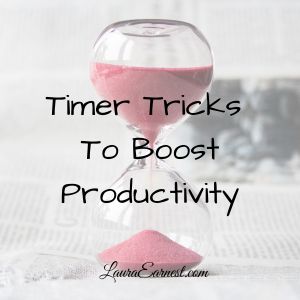Time has always seemed variable to me. Sometimes the same fifteen minute block went by in the blink of an eye, and sometimes it stretched into eternity. The speed of time seemed proportional to my motivation to do a task. When doing a tedious task, I would spend more time looking at the clock than doing the task, and therefore the task took even longer in real time. So how can you remove the perception of time from the equation? Use timer tricks.
A dozen years ago, timers were something I used in the kitchen. I used them to time kitchen things, like boiling eggs and baking cakes. So when I began to hear about “pomodoros” (which at first I took to be some sort of Italian dessert), I was intrigued. A kitchen timer as a productivity tool? It seemed improbable.
Why Use A Timer
As I mentioned above, we as humans have different perceptions of time, depending on what we are doing in the moment. Ask a young child to stop doing something they enjoy, and they will accuse you of not giving them the right amount of time. Timers eliminate that, providing a consistent measure of a span of time.
It’s not just children, though. As adults we also experience shifting time. Timers can provide that absolute feedback on the passage of time without us having to rely on our (faulty) internal clocks.
3 Little Known Tricks With Timers
So timers as a productivity tool. Most people who have been in the productivity space have heard of the Pomodoro Method. But timers can be used in other ways to jumpstart your productivity.
Use A Timer To Get Yourself Started
Sometimes we don’t want to do the task in front of us. Perhaps it is boring or unpleasant or plain not fun.
When you use a timer to get yourself started, you can tell yourself you only have to do the task for five minutes. After all, you can do anything for five minutes, right?
Setting the timer and doing the boring/unpleasant/not fun tasks for five minutes will get yourself started. Once you’re started inertia takes over and you will often find that you want to keep going and finish the task. But if not, take a break and set yourself another five minutes. The task will eventually get done.
Use A Timer to Challenge Yourself
It’s hard to be excited about repetitious tasks. After all, there is no intellectual stimulation in folding laundry.
Using a timer to help you beat your personal records can give you something to engage your mind, making it easier to complete those boring tasks that must be done.
This method is all about beating your personal bests. How fast can you take the garbage to the can? How long does it take you to fold the towels? Set the timer and see if you can break your own records.
Use A Timer To Stop Yourself
Who among us hasn’t stayed up too late because they were reading a book or watching just one more episode? Or who has been late to an appointment or meeting because we were working on something that absorbed us?
Using a timer can help you to stop yourself from overdoing an activity and let you move onto the next. Set a timer for the maximum amount of time you can spend on the activity, and then sit back and enjoy without having to watch the clock!
Summary
Timers are not just about Pomodoro sprints. You can use a timer to get yourself moving, beat your personal best, and stop yourself from spending too much time are little-known productivity tricks.






